The following is a guide to help you identify the cause of yellowing in black pine bonsai.
First, select a pattern that matches the yellowing you see on your tree. Next, check the candidate causes to see if any sound like a match. If you don’t see what you’re looking for, feel free to send me a note using the contact info at the bottom of the page.
Before getting started, take note of the following tips about watering black pine bonsai:
Every day, check the soil 1/4″ – 1/2″ below the surface and gauge the moisture by sight and touch. Ensure the soil is roughly 50% – 70% dry before watering.
Even if it’s been several days since the last watering, it’s OK to wait until the soil begins to dry out before watering again. For details, see the related post, Watering Conifers.
List of Symptoms
- Old needles are turning yellow
- New needles are yellow near the base but green towards the tip
- One or more branches are yellow but the rest of the tree is healthy
- Yellowness accompanied by spots
- Yellowness accompanied by brown or black needle tips
- Shriveled or twisted yellow needles
- General Yellowing
- Yellow on the upper side of needles
1. Old needles are turning yellow
The yellowing of old needles is a natural process that can happen anytime but is most likely to occur in summer or fall. Yellowing of old needles can also follow heat waves or dry spells in which a tree doesn’t get enough water. Apart from addressing any underlying problems (e.g. making sure the tree gets enough water), no treatment is necessary.
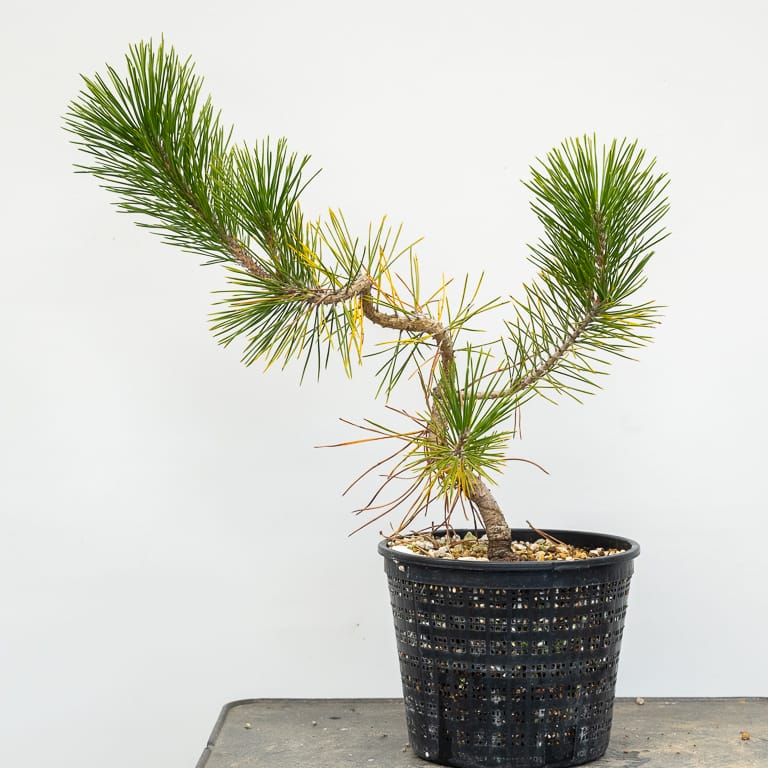
Old needles turning yellow in fall – no treatment necessary
2. New needles are yellow near the base but green towards the tip
This is a common sign of overwatering or overwatering coupled with under-fertilizing. Letting the tree dry out more between waterings and fertilizing if the tree hasn’t been fertilized recently can take care of the problem within a matter of weeks during the growing season.
Mineral deficiencies can also cause partial yellowing on pines, but this is less common. It’s harder to make concrete recommendations for treating deficiencies without knowing the specifics. If proper watering and fertilizing with relatively balanced fertilizers doesn’t help, look at the soil ingredients and water quality to identify mineral excesses or deficiencies and determine next steps.
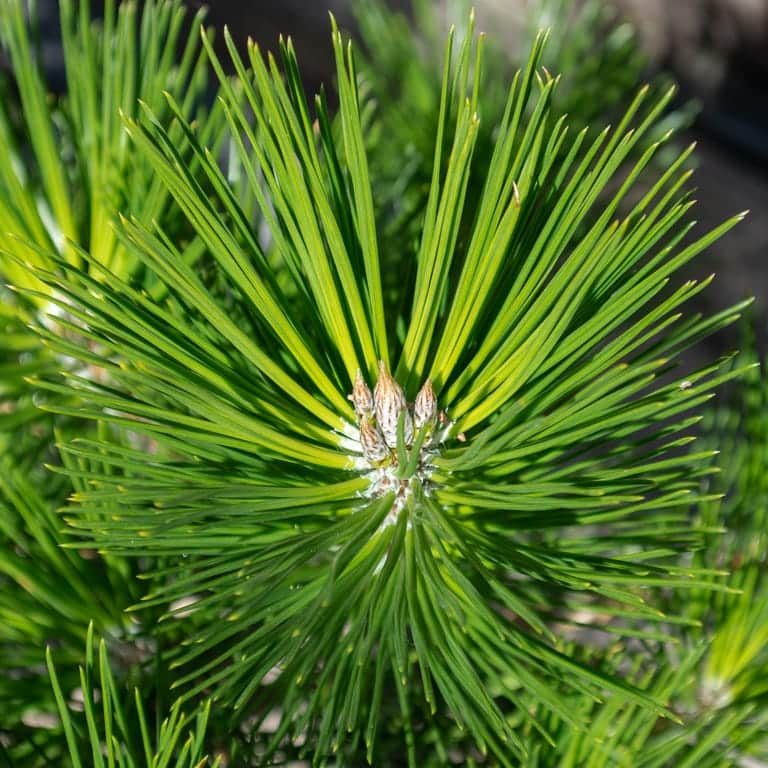
Yellowing near the base of needles indicates overwatering
3. One or more branches are yellow but the rest of the tree is healthy
The two most common causes of local yellowing are physical damage and root problems.
Physical damage can occur when a branch is partially broken or weakened as a result of bumping, bending, or other physical mechanisms. Beyond stabilizing the branch to ensure no further movement, there is little to do in terms of treatment.
Pockets of old soil are the most common cause of localized yellowing involving the roots. If part of the rootball stays too wet or too dry, this can lead to individual branches yellowing or dying. Although it might be too late to save a weakened branch, ensuring the entire root ball is properly watered is the best course of action. At repotting time, replace pockets of old soil with new soil (see an example at: Repotting black pine in nursery soil).
Small, interior branches that don’t receive enough light can also turn yellow or die back. This is a natural process that only affects branches or shoots with inadequate light. To prevent this, make sure all branches that are important to the design of the tree receive adequate light.
A final cause of individual branch yellowing or dieback is boring insects. Learn more about identifying and treating boring insects at the UC IPM website.
4. Yellowness accompanied by spots, banding, or mottled foliage
Spots or “banding” on pine needles can be caused by physical damage (bent or broken needles), pine needle scale (see #7 below), or by a variety of pathogens including blight, needle cast, and related diseases.
In general, there are two components to treating pines with spotted foliage. The first is to address underlying health conditions. When pines are unhealthy, suffering from root diseases, or growing in poor soil, they are much more likely to suffer from foliar pathogens. If the disease is treated but the underlying tree health remains poor, health problems are likely to return.
When it comes to treating foliar diseases, the first step is to identify the pathogen. While some diseases provide very clear symptoms, others are harder to diagnose by sight and require lab tests for a positive ID. Without identifying the pathogen, it’s hard to select a chemical treatment as different fungicides are effective against different pathogens.
Where to begin? Check with an experienced pine grower in your area to see if they have suggestions for treatment options. If you opt for a chemical treatment, follow all instructions on the fungicide label, particularly instructions that relate to how many times a fungicide may be applied before switching to another treatment to avoid breeding resistance. In the meantime, avoid overhead watering as excessive moisture on the needles helps fungi grow.
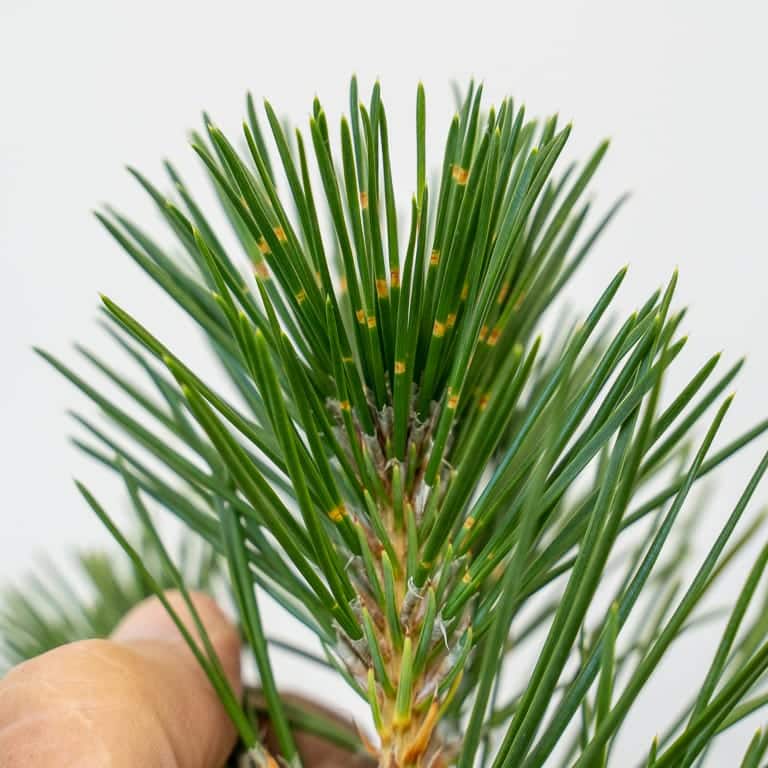
Banding on black pine needles – the roots are infected by a root disease known as cylindrocarpon; the foliage is infected with a pathogen called phoma
5. Yellowness accompanied by brown or black needle tips
Brown or black needle tips are most often caused by poor growing conditions in the soil and/or pathogens in the roots or on the needles.
In cases where the soil is poor or the tree hasn’t been repotted in a long time, improving the soil will improve overall tree health. In mild cases, this can be enough to address discolored needles.
If foliar pathogens like needle cast or blights are a problem where you live, follow the guidance for foliar diseases in section 4 above.
Like needle diseases, root diseases are best diagnosed by sending a sample to a lab. If the pathogen is unknown, it’s hard to determine the best treatment as different fungicides are designed for different diseases. Checking with an experienced pine grower in your area is a good first step.
A final cause of black or brown needle tips is any mineral imbalance. Over-fertilizing is a common cause of mineral imbalances that cause dark needle tips. If there are no obvious culprits, sending foliage, soil, and/or water samples to a lab can provide good next steps.
6. Shriveled or twisted yellow needles
Shriveled, twisted, and yellow needles on black pine are commonly caused by root pathogens, specifically pythium. Mild temperatures and excessive moisture favor pythium growth so keeping affected pines on the dry side and using soil that doesn’t stay too wet can help stave off the pathogen.
Sending root samples to a lab is the best way to diagnose root diseases like pythium. Chemical treatments are available but do note that not all systemic fungicides will be effective against pythium so be sure to check the label before proceeding.
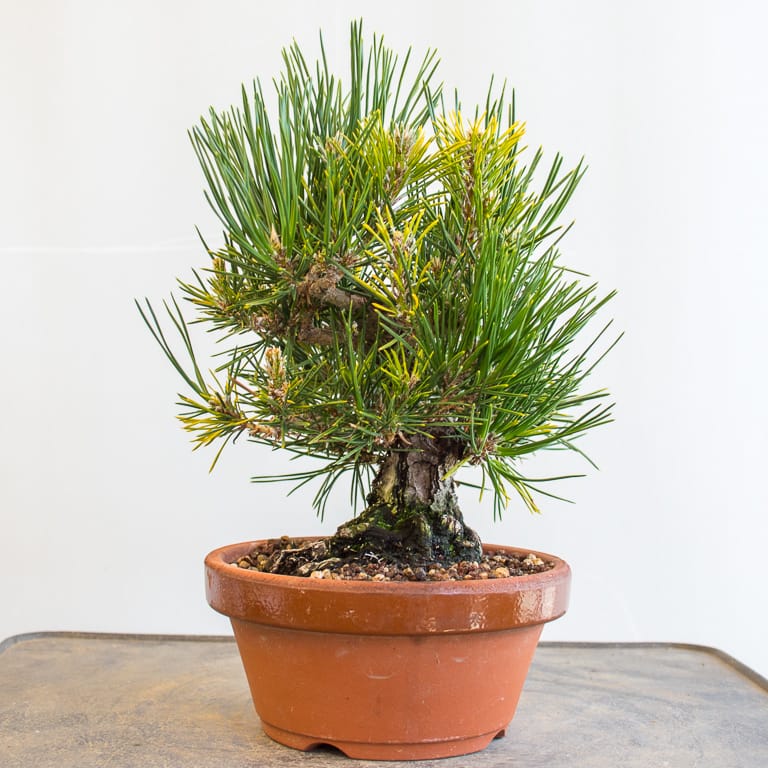
Pythium damage on black pine
7. General Yellowing
This is the most common form of yellowing on black pine bonsai. Here’s a checklist of potential causes to help you identify likely culprits.
- Cool temperatures. Pines commonly yellow over winter. This is normal and will correct itself in spring if the tree is otherwise healthy.
- Not enough fertilizer. Try using more! Applying liquid fertilizer to the foliage can provide a quick boost, as can using chelated iron.
- Poor soil. Soil that retains too much water makes it hard for pines to develop healthy roots. Try using larger soil particles or particles that retain less moisture.
- Too much water. It’s possible to overwater a pine whether or not it’s planted in great soil. Letting trees dry out between waterings, up to 50% – 70%, gives healthy roots a chance to grow.
- Not enough water. Letting pines get too dry between waterings can stress roots and lead to yellow needles. Pockets of broken-down soil can prevent water from reaching roots even when a tree is watered frequently. Perforating the rootball with a screwdriver or letting the tree soak in water for a while can help water reach all of the roots.
- Poor water quality (too many salts). Water that is high in salts can decrease general health and make pines susceptible to infestation or disease. Check your water municipality’s water report to learn more about your water quality. Hose-end filters or reverse osmosis systems can remove salts from water and improve overall tree health.
- Water pH is too high. The higher the pH, the harder it is for pines to absorb nutrients. A pH meter (or checking your municipality’s water report) is a good place to start. Pines benefit from water with pH 5.5-6.5, and it can be relatively easy to acidify the water to get the pH into this range. Learn more about acidifying water for bonsai.
- Root aphids. A relatively small number of root aphids can weaken pines and turn foliage yellow. A common sign of root aphids in young pines is when several pines in a flat are yellow and the rest are healthy. Many treatments work for root aphids including horticultural soap drenches or systemic insecticides.
- Spider mites. Look closely at yellow foliage to see if the yellow is even and consistent or composed of thousands of tiny yellow spots. If it’s the latter, spider mites are the likely cause. Here’s a primer for spotting and treating spider mites on pine bonsai.
- Pine needle scale. These small white insects can cause spots, banding, and general yellowing on pines. See the following tips for identifying and treating pine needle scale.
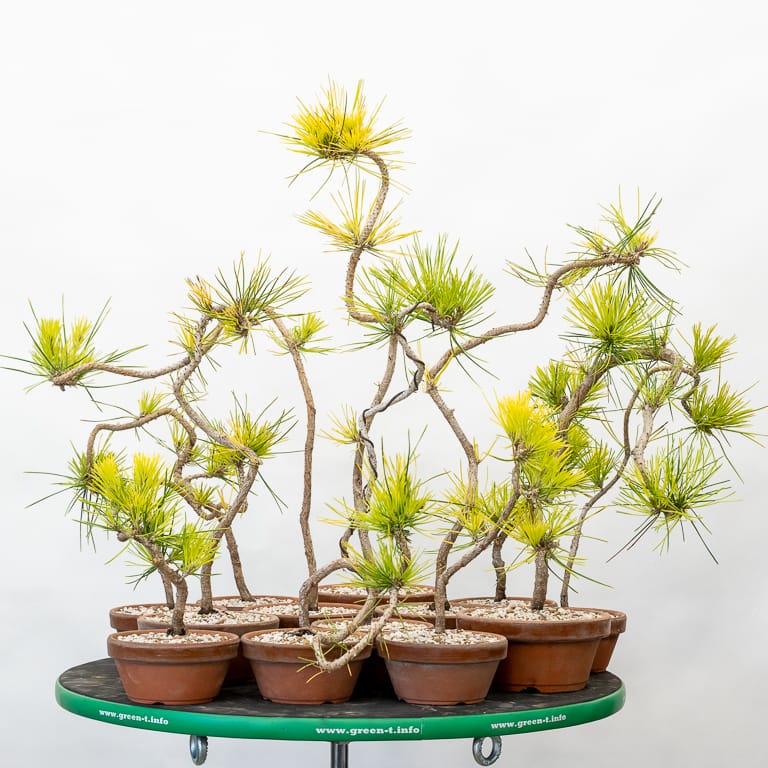
General yellowing on pines that were grown in poor soil
8. Yellow on the upper side of needles
When needles that developed in the shade are exposed to strong sunlight, particularly after a nearby branch is removed, tender foliage can burn. If you catch this right away, move the tree into a relatively shady location for a few weeks and gradually bring the tree back out in the sun. No treatment is needed for sunburned foliage.
Examples
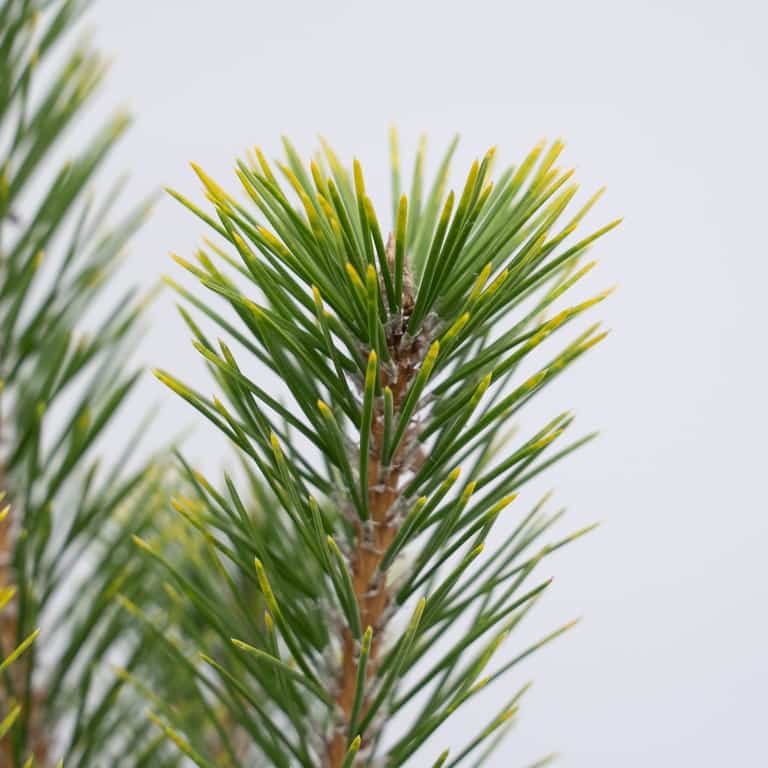
Mottled yellow foliage likely caused by poor soil and/or root pathogens; I plan to repot and see if that takes care of the problem
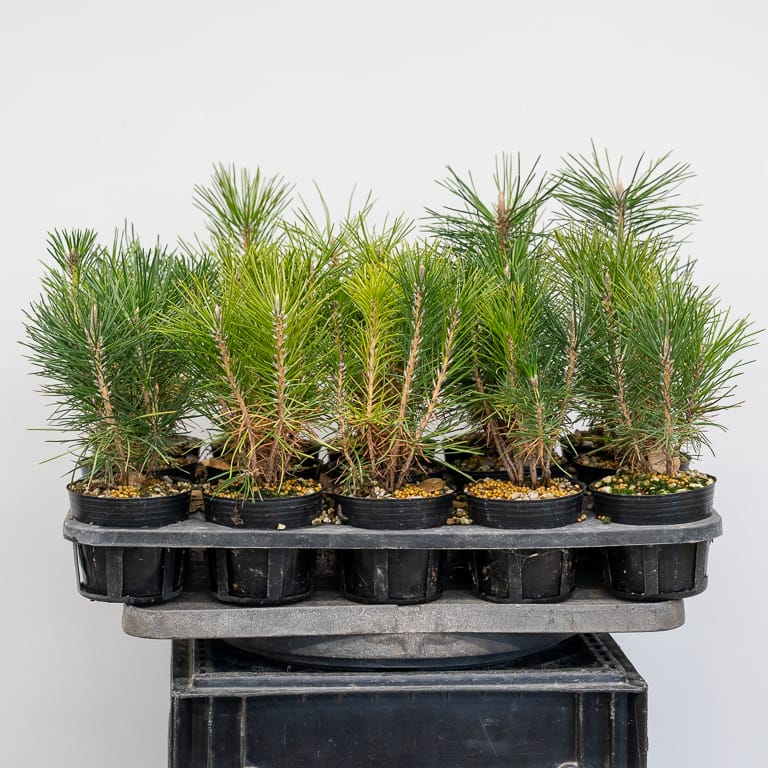
Several yellow pines among healthy green seedlings – a common sign of root ahpids
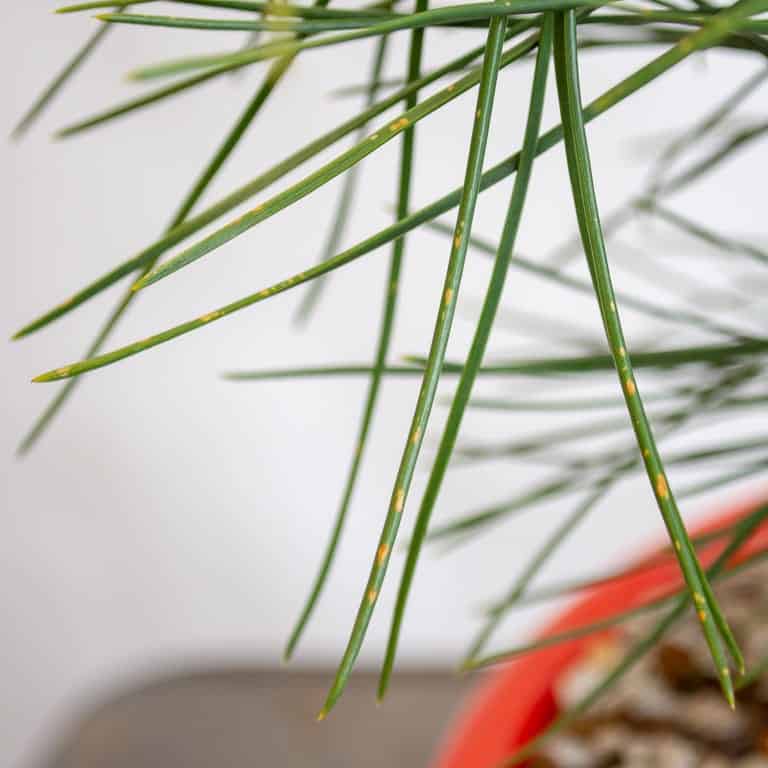
Spots caused by hail damage – no treatment necessary
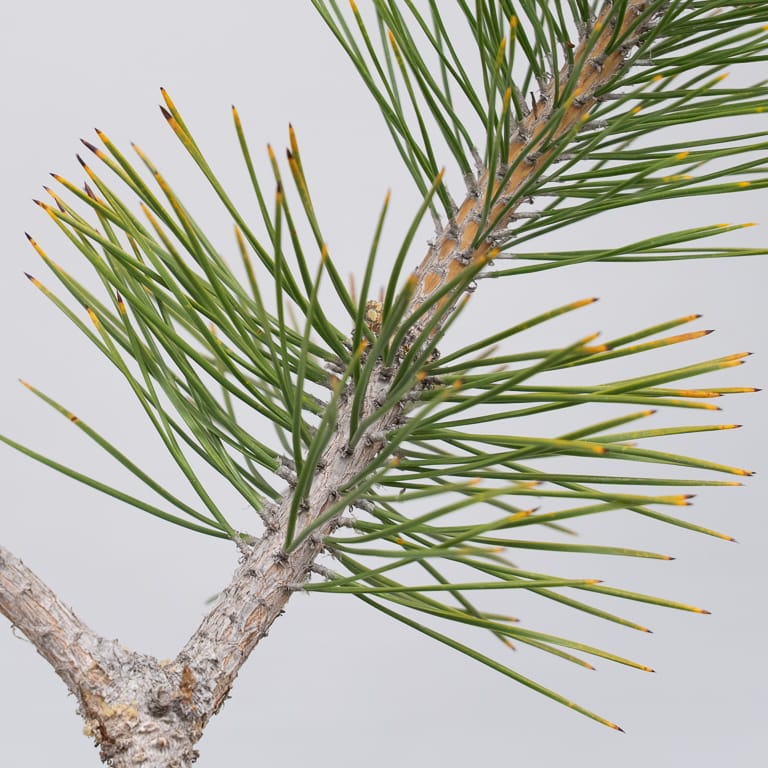
Yellow and brown tips on old needles likely caused by poor growing conditions (water, fertilizer, or soil)- treatment is not necessary as the new needles are healthy
I plan to update this resource as need be so feel free to let me know using the contact info below if you have questions or suggestions for improvements.
Subscribe to Bonsai Tonight
New Posts Delivered Every Tuesday and Friday